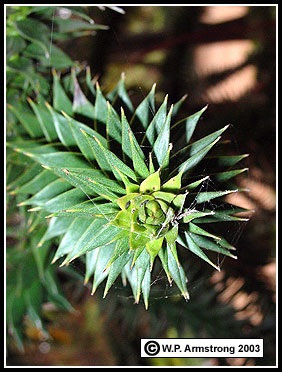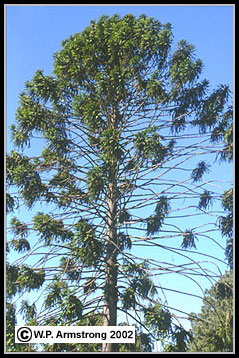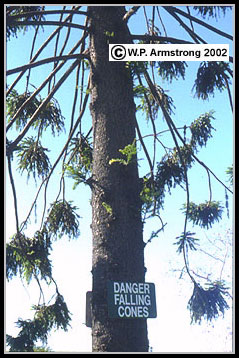|
Woods: Araucaria
| Economic Plant Photographs #27 |
The Araucaria Family: Araucariaceae
|
Woods With Beautiful Grains
|
Cook pines (Araucaria columnaris) showing the natural pruning of lateral branches in deep shade. The whorls of lateral branches (appearing as bumps on the tree trunks) produce the striking knots in furniture and bowls made from this wood. Cook pines are native to New Caledonia and were introduced throughout the Hawaiian Islands.
|

|
The slender, spirelike crowns of Cook pine (Araucaria columnaris) form a striking contrast with the rugged mountains of Kauai, Hawaii. Cooks pines are native to New Caledonia and were introduced throughout the Hawaiian islands.
|
The araucaria family (Araucariaceae) contains three remarkable genera of
cone-bearing trees: Araucaria, Agathis and Wollemia. They are tall trees native to forested regions of
South America and Australia. In majestic size and beauty, they certainly
rival the coniferous forests of North America and Eurasia. In fact, they
are considered the southern counterpart of our northern pine forests. The
type genus Araucaria is derived from "Arauco," a region in central Chile where the Araucani Indians live. This is also the land of the "monkey
puzzle" tree (A. araucana), so named because the prickly, tangled branches would be difficult for a monkey to climb. Fossil evidence indicates that ancestral araucaria forests resembling the present-day monkey puzzle date back to the age of dinosaurs. In fact, it has been suggested that the tree's armor of daggerlike leaves was designed to discourage enormous South American herbivorous dinosaurs, such as Argentinosaurus weighing an estimated 80 to 100 tons! Another ancient South American
species called pino paraná or paraná pine (A. angustifolia) grows in
southern Brazil and Argentina.
|
A South American monkey puzzle tree (Araucaria araucana). The prickly, tangled branches would probably be difficult (and painful) for a monkey to climb. Fossil evidence indicates that ancestral araucaria forests resembling the present-day monkey puzzle date back to the age of dinosaurs.
|

|
Close-up view of the dense, sharp-pointed leaves of the monkey puzzle tree (Araucaria araucana). This species does not grow well in southern California, but forms beautiful specimen trees in the Pacific northwest and England. An ancestral species formed extensive forests in Europe during the Jurassic Period, about 150 million years ago.
|

|
A monkey puzzle tree (Araucaria araucana) in the hot Sacramento Valley of northern California. The photograph was taken at Bidwell Park in Chico. Although this species does not grow well in arid southern California, it is occasionally planted in parks and gardens of northern California. It grows much better in colder climates of Oregon and Washington with more rainfall.
|
Australian members of the Araucariaceae include the prickly-leaved
bunya-bunya (A. bidwillii) with huge pineapple-shaped cones, the hoop pine
(A. cunninghamii) an important Australian timber tree, the Cook pine (A.
columnaris) native to New Caledonia, and the Norfolk
Island pine (A. heterophylla) native to Norfolk Island. [Both islands are located off the east coast of Australia.] The latter species
is commonly grown in containers in southern California and is sold as "star
pine" because of its horizontal tiers of radiating limbs. Throughout San
Diego County "star pines" can easily be recognized by their tall, slender
spires of tiered limbs. This species was discovered by Captain James Cook
during his second voyage to Australia and New Zealand (1772-1775). The
closely related Cook pine of New Caledonia that is naturalized throughout
the Hawaiian Islands is named after this famous English explorer. Like the
Norfolk Island pine, the bunya-bunya has an unmistakable silhouette with its
barren, horizontal limbs tufted at the ends with spiny leaves. The huge seed cones of tall trees pose a serious threat to unsuspecting persons sitting beneath
its cone-laden limbs.
|
An Australian bunya-bunya tree (Araucaria bidwillii) growing in a park in Carlsbad, California (San Diego County). The seed cones of this species are larger than pineapples and pose a serious threat to unsuspecting persons sitting beneath the cone-laden limbs.
|
Bunya-Bunya: One Of The Largest Seed Cones Produced By A Conifer

|
What does a bunya-bunya seed cone have in common with a ripe pineapple? They are both heavy and could cause injury if dropped on an unprotected head from a distance of 75 feet (23 m). Unlike bunya-bunya cones, pineapples do not drop from the limbs of tall trees.
|
|
At Quail Botanical Garden in Encinitas (San Diego County) the trail
near the bunya-bunya trees is closed during August and September.
|

|
Bunya-bunya (Araucaria bidwillii) seed cone (left) and Coulter pine (Pinus coulteri) seed cone (right), two of the largest cones produced by cone-bearing trees (division Coniferophyta). Green bunya-bunya cones typically weigh 10 pounds (4.5 kg) or more. Green, unopened Coulter pine cones typically weigh 5 to 8 pounds (up to 3.6 kg). Cones of both species can be harmful if they fall from the upper branches of mature trees and hit your unprotected head.
|

|
A large bunya-bunya seed cone that has just hit the ground at the San Diego Wild Animal Park. Note the ovuliferous scale or megasporophyll (white arrow)
bearing a single large seed on its upper surface.
|

|
An ovuliferous scale (megasporophyll) and several large seeds from a bunya-bunya cone. Each scale bears one seed on its upper surface. The lower right seed has been removed from its woody seed coat. The nutritious seeds were harvested and eaten by Australian Aborigines.
|
|
Left: A bunya-bunya tree in Santa Barbara, California. This Australian conifer has an unmistakable silhouette with its
barren, horizontal limbs tufted at the ends with spiny leaves. Right: Resinous sap oozing out of the trunk of a large bunya-bunya.
|
Also in the araucaria family is the genus Agathis with more than a
dozen species of large, resinous trees scattered throughout Australia, New
Zealand and the Malay Archipelago. Several species of Agathis are the source of timber and valuable copal varnish, including kauri pine (A. australis), amboina pine (A. dammara) and dammar pine or Queensland kauri
(A. robusta). Copals are a group of resins that form particularly hard varnishes. In addition to Agathis, there are New World sources of copal from resinous leguminous trees, including the West Indian locust (Hymenaea courbaril) and several species of Copaifera. Dammars are another group of
hard, durable varnishes that turn shiny and transparent when dry. Although some species of Agathis are named dammar, most dammar resins come from tropical Asian trees of the genus Shorea in the Diptocarpaceae. Copals and dammars are used extensively in oil paintings. When painting with oils, colored pigment is squeezed onto a palette and then taken up in a thinning solution of linseed oil mixed with either copal or dammar. The resins "hold" the paint when dry and provide the luminous depth characteristic.
In 1994, David Noble discovered an unknown cone-bearing tree in rugged
Wollemi National Park northwest of Sydney, Australia. About 40 trees in
deep narrow canyon turned out to be an undescribed species. They were
named Wollemi pine (Wollemia nobilis), a remarkable new member of the
Araucariaceae. This rare conifer was thought to be extinct because its
last fossil record was dated at about two million years ago. Choroplast
DNA studies show no discernable genetic variation among the 40 trees. Like the rare Torrey pine (Pinus torreyana) of San Diego County, this is truly a relict population that was more widespread millions of years ago. Because of its small population size, a lot of its genetic diversity has been lost through thousands of years of isolation. The Wollemi pine is a great botanical discovery and is truly a "living fossil." Trees are being
propagated from seeds, and who knows, maybe some day this tree will be
cultivated in San Diego County like other living fossils such as the
maidenhair tree (Ginkgo biloba) and dawn redwood (Metasequoia
glyptostroboides).
|
Left: A cone-bearing branch from the Norfolk Island pine (Araucaria heterophylla), a close relative of the Cook pine (A. columnaris). The branches of both species are densely clothed with small, overlapping, triangular leaves. Right: A cone-bearing branch from the dammar pine or Queensland kauri (Agathis robusta), another interesting Australian member of the Araucariaceae. The leaves of this species are unusual among conifers because they are broad-leaved rather than needlelike or scalelike.
|
Although they are often referred to as pines, members of the araucaria
family have seed cones and foliage that is very different from the pine
family (Pinaceae). Conifers in the pine family have cone scales with a
pair of ovules (seeds) on the upper surface. Each cone scale is subtended
by a distinct bract which is conspicuously exerted in some California
species, such as the Douglas fir (Pseudotsuga menziesii) and Santa Lucia
fir (Abies bracteata). Members of the araucaria family have only one ovule
per scale and have bracts that are fused to the scale or none. Unlike the long, slender
needles of pines (Pinus), araucarian leaves are typically short,
overlapping and often prickly. Some species have broad leaves that
superficially resemble leaves of flowering plants. In their native habitats, the araucarias become tall timber trees up to 200 ft. (61 m).
|
View of upper (adaxial) surface of the seed-bearing scales from female (ovulate) cones of the Australian bunya-bunya (Araucaria bidwillii) and the southern California Coulter pine (Pinus coulteri). The araucaria scale has a single large seed, while the pine scale bears a pair of winged seeds. Cones from both of these species can be very large, weighing up to ten pounds or more. Araucaria cones fall apart at maturity, so you don't tend to find old, intact cones on the ground beneath the trees.
|
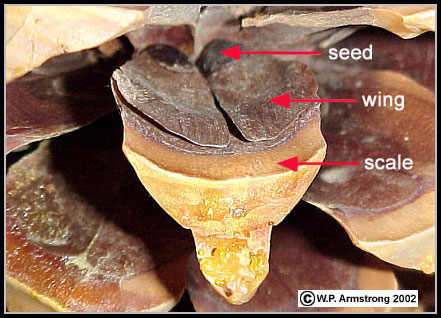
|
Close-up view between the scales of a large female cone from a Coulter pine (Pinus coulteri). Each scale bears two winged seeds on its upper (adaxial) surface. Each pine scale is also subtended by a woody bract (not shown in this photo). In some genera of the pine family (Pinaceae), such as Pseudotsuga menziesii (Douglas fir) and Abies bracteata (Santa Lucia fir), the subtending bracts are conspicuously exerted. Araucaria cones have only one seed that is fused to the scale.
|

|
Branchlets of three South Pacific species of Araucaria native to Norfolk Island and Australia. Although they are called "pines," they do not belong to the pine family (Pinaceae). Unlike the slender needles of pines, araucarian leaves are quite variable depending on the species. Top: Norfolk Island pine (A. heterophylla) with dense, overlapping, awl-shaped leaves. Middle: Hoop pine (A. cunninghamii) with flattened, needlelike leaves. Bottom: Bunya-bunya pine (A. bidwillii) with broad, sharp-pointed leaves.
|
Petrified Araucariads From The Dinosaur Era
Fossil evidence indicates that the araucaria family reached its
maximum diversity during the Jurassic and Cretaceous periods between 200
and 65 million years ago, with worldwide distributions. At the end of the
Cretaceous, when dinosaurs became extinct, so did the Araucariaceae in the
northern hemisphere. Until the middle of the Tertiary Period (135 million
years ago), trees of the Araucariaceae grew in forests of the southern
supercontinent called Gondwanaland, when South America and Africa were
connected with each other and with Anarctica, India and Australia. By 65
million years ago, the continents had divided into positions resembling their
present-day configuration. During this time interval, araucariads began a
slow decline in range and diversity as flowering plants, better adapted to
climatic changes, began to evolve and gradually displace conifers.

|
In 1915 Alfred Wegener, a German climatologist and geophysicist, published an expanded version of his 1912 book The Origin of Continents and Oceans. This novel hypothesis, which has now been confirmed by other scientists, states that continents are not fixed; instead, their relative positions and the positions of the oceans have changed over time. Wegener's hypothesis led to the science of plate tectonics, where scientists study the gradual movement of large plates of the earth's crust along major fault zones. About 200 million years ago, the continents were joined into one supercontinent that Wegener called Pangea (Figure A). By 135 million years ago, Pangea had divided into two large subcontinents called Gondwanaland and Laurasia (Figure B). In the great southern subcontinent Gondwanaland, South America and Africa were connected with each other and with Antarctica, India, and Australia. This is roughly the time when the first flowering plants began to appear on earth. By 65 million years ago, about the time when dinosaurs became extinct, the continents had divided into positions resembling the present-day configuration (Figure C). As of April 2000, the continents resembled the configuration shown in Figure D.
|
Petrified Forest National Park in northeastern Arizona contains hundreds of acres of perfectly preserved logs from an ancient conifer forest that dates back to the late Triassic Period (approximately 225 million years ago). The trees of this forest coexisted with dinosaurs. Most of the petrified logs were previously assigned to the extinct species Araucarioxylon arizonicum, a presumed distant relative of Araucaria; however, new evidence indicates that these fascinating deposits of petrified logs represent a broad diversity of conifer species. Streams carried dead logs into this once swampy lowland region where they were buried in sediments rich in volcanic ash. Over countless centuries, the woody tissue has been replaced by minerals and gradually turned into stone. These ancient trees flourished during a time when all of the continents were united into the vast supercontinent Pangea. The area of Petrified National Park was located near the equator, at approximately the latitude of present-day Central America. Many of the reddish, agatized logs do not show cellular detail; however, there are some permineralized specimens in which minerals permeated the porous cell walls and filled the cell cavities (lumens). Thin sections of these samples viewed under a microscope show remarkable cellular detail.
Although the binomial Araucarioxylon arizonicum has been used in the literature for more than a century, Rodney A. Savidge of the University of New Brunswick (Bulletin of Geosciences Vol. 82 No. 4: 301-328, 2007) states that it is superfluous and therefore an illegitimate name (nomen superfluum). He examined thin sections of the original three specimens (syntypes) housed at the Smithsonian Institute upon which the species was first described by F.H. Knowlton in 1889. He concluded that they represented different species within two new genera of extinct trees. According to the International Code of Botanical Nomenclature, a valid species can have only one type specimen or holotype. Consequently, only one of the three specimens was retained as the new type or lectotype Pullisilvaxylon arizonicum. Savidge examined several other logs previously identified as A. arizonicum and concluded that they also represented additional new genera and species. His extensive anatomical studies indicate that the majority of logs at Petrified Forest National Park do not belong to a single species. It appears that the superfluous name "A. arizonicum" actually refers to a complex of extinct conifers. Based solely on the tracheid structure of permineralized wood (including resin canals, rays and tracheid pitting), and without DNA evidence, it is difficult to be certain which trees in the complex are ancestral relatives of the araucaria family. According to Dr. Savidge (personal communication, 2008), an immense amount of research into petrified woods is needed before the ancestries leading to modern trees will be clearly understood. At this time it would be purely conjectural to assign a scientific name to most logs in Petrified Forest National Park without detailed microscopic examination of the wood.
Trees of "Araucarioxylon arizonicum" grew to a height 200 feet (61 m) with a trunk diameter from 4 to 9 feet. According to Sidney R. Ash and Geoffrey T. Creber (Paleontology Vol. 43 No. 1: 15-28, 2003), the living tree did not closely resemble any of the present-day Araucaria trees of the southern hemisphere as postulated in past reconstructions. The branches did not occur in whorls as they do in most conifers, instead they grew irregularly along the trunk. Sydney Ash and Rodney Savidge also studied the bark anatomy of Araucarioxylon arizonicum ("The Bark of Late Triassic Araucarioxylon arizonicum from Petrified Forest National Park, Arizona," IAWA Journal 25 No. 3: 349-368, 2004), and concluded that it was quite unlike the banded bark of extant Araucaria heterophylla. These ancient conifers grew in a tropical rain forest with marshes and river lakes, in an environment very different from today's Arizona landscape.
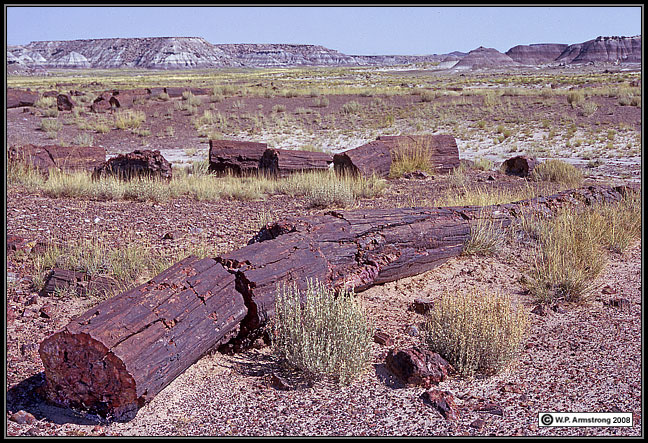
|
Petrified Forest National Park in Arizona contains hundreds of acres of perfectly preserved logs from an ancient tropical flood plain during the late Triassic Period (over 200 million years ago). The trees of this extinct forest coexisted with dinosaurs. Many of the petrified logs have been assigned to the genus Araucarioxylon, a presumed distant relative of Araucaria; however, new evidence indicates that these petrified logs represent a broad diversity of conifer species. Streams carried dead logs into this once swampy lowland region where they were buried in sediments rich in volcanic ash. The woody tissue of the logs became impregnated with minerals such as silica and gradually turned into stone.
|
Trees of the "Araucarioxylon arizonicum" grew to a height 200 feet (61 m) with a trunk diameter from 4 to 9 feet. According to Sidney R. Ash and Geoffrey T. Creber (Paleontology Vol. 43 No. 1: 15-28, 2003), the living tree did not closely resemble any of the present-day Araucaria trees of the southern hemisphere as postulated in past reconstructions. These ancient conifers grew in a tropical region with marshes and river lakes, an environment very different from today's Arizona landscape.
|

|
Diorama of araucariad forest from 200 million years ago, when all the continents were united into the vast supercontinent Pangea. Whether any logs at Petrified Forest National Park came from trees such as these is unknown at this time. From all the thousands of petrified logs, one can only imagine the extent and diversity of this ancient forest of giant trees. Diorama on display at the Rainbow Forest Museum, Petrified Forest National Park.
|

|
The ovulate (seed) cones of the Norfolk Island pine (Araucaria heterophylla) are similar to the Cook pine (Araucaria columnaris). The ovuliferous scales are deciduous and fall from the woody cones at maturity, thus releasing the seeds (one seed per scale).
|
|
A petrified ovulate cone of Araucaria mirabilis from Patagonia, Argentina. This extinct species of Araucaria dates back to the Jurassic Period (135-180 million years ago), when giant dinosaurs ruled the earth. Although prickles on the cone scales have worn away after millions of years of erosion, the cone is remarkably similar in appearance to modern-day species of Araucaria. [Fossil cone from collection of San Diego Gem & Mineral Society.]
|
|
Another petrified ovulate cone of Araucaria (probably A. mirabilis) from Patagonia, Argentina. This extinct species of Araucaria dates back to the Jurassic Period (135-180 million years ago), when giant dinosaurs ruled the earth. Although prickles on the cone scales have worn away after millions of years of erosion, the cone is remarkably preserved. The right view clearly shows one seed per scale (black arrow), typical of modern-day species of Araucaria.
|
For decades Baltic amber has been arbitrarily assigned to an extinct pine (Pinus succinifera) because of the presence of succinic acid; however, IR (infrared spectroscopy) studies show that
Baltic amber may be more closely related to resins of broad-leafed
conifers of the araucaria family (Araucariaceae). According to J.H. Langenhein (Plant Resins: Chemistry, Evolution, Ecology, and Ethnobotany, 2003), Baltic amber contains pinaceous inclusions (wood fragments and cones) but with araucarian chemical characteristics, so the origin of these vast deposits remains an enigma. Today the only
evidence of araucariads in the northern hemisphere comes from amber
deposits and petrified wood, such as occurs at
Petrified Forest National Park in Arizona. In New Zealand a living
araucariad forest of "kauri pine" Agathis australis produces copious amounts of
resin that once formed a thriving industry for hard, durable
varnishes and linoleum. Large lumps of hardened resin (up to 100 pounds in size) were dug out of the ground in extensive forested areas of North Island. Forests such as this may have once flourished in the Baltic region 60 million years ago. Throughout
the world, the most copious resin-producing trees occur in tropical
regions. These complex mixtures of terpene resins may serve as a
chemical defense against the high diversity of plant-eating insects
and parasitic fungi found in the tropics.

|
Globs of raw resin (pitch) oozing out of the trunk of the hoop pine (Araucaria cunninghamii), a large timber tree in forests of eastern Australia. In New Zealand, a living
araucariad forest of "kauri pine" Agathis australis produces copious amounts of
resin that once formed a thriving industry for hard, durable varnishes and linoleum.
|

|
Milky, opaque resin oozing out of the trunk of a hoop pine (Araucaria cunninghamii), a large timber tree in forests of eastern Australia. This large tree was cut down in October 2004 to make room for the new Science Building at Palomar College. Unlike the clear resins of pines (Pinus), this resin superficially resembles vanilla frosting.
|
|
Baltic amber necklace. For decades, Baltic amber has been arbitrarily assigned to an extinct pine (Pinus succinifera); however, IR (infrared spectroscopy) studies show that Baltic amber is more closely related to resins of broad-leafed conifers of the araucaria family (Araucariaceae). Forests similar to the present-day "kauri pine" Agathis australis in New Zealand may have once flourished in the Baltic region 60 million years ago, and may be the source of precious fossilized resin known today as "Baltic amber."
|
Any discussion of fossilized araucariads would be incomplete without mentioning a medieval gemstone called jet. Jet is a semiprecious gem excavated in Europe and formed by the metamorphosis and anaerobic fossilization of conifer wood buried under sediments in ancient seas. Ancestral forests that metamorphosed into jet date back to the Jurassic Period, about 160 million years ago. Some authors have suggested that these forests were similar to present-day araucaria forests in South America; however, this has not been substantiated in peer-reviewed botanical journals. Coal deposits are often formed from a variety of decayed woods. Chemically, jet it is a hard, carbonized form of bituminous coal with a density similar to anthracite coal. Anthracite can be readily identified by its metallic luster. Jet takes a high polish and has been used for shiny black jewelry for thousands of years. It has a specific gravity of 1.3, almost as hard as the ironwood called lignum vitae (Guaiacum officinale). Jet became very popular during the mid 19th century England during the reign of Queen Victoria, and was often worn to ward off evil spirits and during times of mourning. In the first century AD, the Roman naturalist and writer Pliny described the magical and medicinal attributes of this beautiful mineral. The well known analogy of "jet" and "black" was coined by William Shakespeare in his "black as jet" from Henry VI part 2. One of the most famous areas for the mining of Victorian jet is Whitby on the rugged Northeast coast of England.
|
Although they are similar in hardness, anthracite has a metallic luster and jet is dull black. Jet takes a high polish and has been used in various carved jewelry, such as cameos and intaglios. The Victoria jet broach (circa 1890) was a popular item of jewelry during the 19th century.
|
Which Species Of Araucaria Grow In Southern California?
Most older references list four species of Araucaria commonly cultivated in southern California, including A. heterophylla (Norfolk Island pine), A. bidwillii (bunya-bunya), A. cunninghamii (hoop pine), and A. araucana (monkey puzzle). The latter species does not do well in the arid climate of southern California; however, I have seen small trees in parks and gardens of central and northern California. The Norfolk Island pine typically has well-spaced, tiered, horizontal limbs and a distinctive silouette that is easy to spot from a distance; however, there are also trees with more closely-spaced limbs and a columnar, slender crown resembling the Cook pine (A. columnaris). According to Trees of Hawaii by Angela Kepler (1990), most of the trees called Norfolk Island pine in Hawaii are actually Cook pines. They are naturalized throughout the Hawaiian Islands and have been exported as lumber and container-grown "Christmas trees" to the U.S. mainland. So it looks like some our southern California Norfolk Island pines are actually Cook pines, particularly if they were imported from Hawaii.
According to M.G. Buck and R.H. Imoto (1982), Norfolk Island and Cook Pines were introduced to Hawaii in 1860. The two species probably hybridized and were subsequently dispersed throughout the islands. All juvenile trees today show A. columnaris traits and should probably be labeled as A. heterophylla x columnaris. The trees are commonly propagated by seedlings. If these are exported to the mainland, it is possible that some of our cultivated specimens are indeed hybrids. Research forester P.G. Scowcroft (1988) states that Araucaria columnaris is the most abundant Araucaria species in the Hawaiian Islands, and that A. heterophylla is sparsely represented in Hawaii. According to Elbert L. Little, Jr. and R.G. Scolmen (1989), some exported seeds may be hybrids; however, hybridization is unlikely because the two species shed pollen six months apart. in addition, seed and foliage samples sent to Kew Gardens were all identified as A. columnaris. Dr. Little also states that seeds of A. heterophylla are larger, with a "swollen body to one cm thick." The four cotyledons on seedlings are also wider, 3 to 5 mm compared with 1.5 for A. columnaris.
- Buck, Michael G. and Roger H. Imotos. 1982. "Growth of 11 Introduced Tree Species on Selected Forest Sites in Hawaii." Pacific Southwest Forest & Range Experiment Station Research Paper PSW-169. Forest Service, U.S. Department of Agriculture. 12p.
- Little, E.L., Jr., and R.G. Scolmen. 1989. Common Forest Trees of Hawaii. Agriculture Handbook No. 679. Forest Service, U.S. Department of Agriculture.
.
- Scowcroft, Paul G. 1988. "Germinabiliy of Cook Pine (Araucaria columnaris) Seeds under Different Storage Conditions." USDA Forest Service, Pacific Southwest Forest and Range Experiment Station, Institute of Pacific Islands Forestry, Honolulu, Hi.
|








